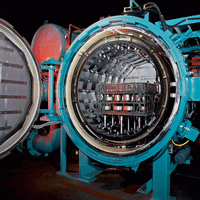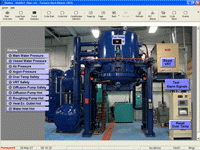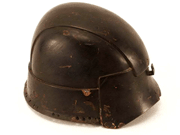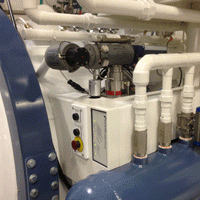In vacuum processing, metal surfaces remain very clean and free of oxides. When these near-perfect surfaces are in contact with other surfaces, certain elements have a tendency to interact between the surfaces through solid state diffusion. Therefore, a major consideration when selecting both hearth and load fixturing materials for vacuum heat treating is the possibility of solid state diffusion between different materials in contact at high temperatures. Solid state diffusion of certain elements can cause the formation of a lower melting point alloy called a eutectic. For example, solid state diffusion between carbon and nickel can begin to occur at temperatures as low as 1165ºC (2130ºF) and cause local melting, also known as eutectic melting. BY JEFF PRITCHARD
Archives for April 2014
Why Heat Treat in a Vacuum?
The air we breathe contains a number of elements that can react with metals under the proper conditions. Moisture, oxygen, carbon dioxide and hydrogen are present in significant amounts in our atmosphere. Each can react to varying degrees with many different metals. While many of these reactions occur to only a small extent at room temperature, they are often greatly accelerated in the presence of heat. Consider the example of a piece of polished metal held over a heat source. It will eventually turn blue or black as the elements in the atmosphere react with the hot metal.
In most cases, the heat treater tries to minimize the extent of these reactions during heat treating. The reactions cause changes in the surface properties of the metal that may result in a heat treated component with a “skin” that is much softer (or harder) than the rest of the component. To minimize these undesirable reactions, the source of the reactive elements, air, must be eliminated from the heat treating environment. Sometimes this is done by replacing the air in a heat treating chamber with a non-reactive atmosphere such as nitrogen, argon or other gas mixtures. This is often referred to as controlled atmosphere heat treating. Another alternative is to heat treat in a bath of non-reactive molten salt. However, these environments still contain some very low levels of residual impurities so metals heat treated in a controlled atmosphere or salt usually exhibit a small amount of discoloration. BY JEFF PRITCHARD
Fracture of a 17th Century Japanese Helmet
There was a crack in the helmet which is not visible in this image (some associated damage can just be seen in the lower left side of the helmet visor). The crack was opened and the fracture began at a streak with mostly intergranular fracture and then propagated by cleavage as shown below.
Note the intergranular fracture in the center foreground. The walls show transgranular cleavage the propagated from the intergranular origin. Next to the fracture, we see a region of columnar grains at the surface with a small region of finer, more equiaxed grains below and the very coarse columnar grains blow that, as shown below.
Residual Gas Analyzers
A residual gas analyzer or RGA for short is a compact mass spectrometer, designed for use either in the laboratory or out on the shop floor. These devices are often mounted for in-situ use on a vacuum furnace. RGA’s are typically designed for process control and contamination monitoring in vacuum systems.
Applications for residual gas analyzers include distinguishing leaks from outgassing, fingerprinting the process background, detecting helium and determining the effectiveness of gas line purging. A typical RGA gas analysis can reveal how much of a particular species is present either in the vacuum vessel or in the pump manifold. RGAs are used in most cases to monitor the quality of the vacuum and easily detect minute traces of impurities in the low-pressure gas environment. These impurities can be measured down to 10-14 Torr levels, possessing sub-ppm detectability in the absence of background interferences. RGAs can also be used as sensitive in-situ, helium leak detectors. With vacuum systems pumped down to lower than 10-5 Torr for checking of the integrity of the vacuum seals and the quality of the vacuum to detect air leaks, virtual leaks and other contaminants at low levels before a process is initiated.




